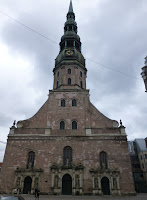 Rīga is the capital of Latvia and the largest city in the Baltics. The city is home to 702,000 people, about 1/3 of the country's population. The greater metro area has a population just over 1 million.
Rīga is the capital of Latvia and the largest city in the Baltics. The city is home to 702,000 people, about 1/3 of the country's population. The greater metro area has a population just over 1 million. 
Riga sits on the Gulf of Riga and the Daugava River runs through the city.
 |
| Big Christopher |
 Historically speaking...Riga was founded in 1201. During the Middle Ages it was a Viking
trading center. In 1282 Riga joined the Hanseatic League. Over the
years it has been a part of Sweden and the Russian Empire. After WWI,
it was the capital of an independent Latvia before it was annexed by the
Soviet Union. During WWII it, and the rest of the country, was
occupied by Germany before being retaken by the USSR. In 1991 it once
again became the capital of an independent Latvia.
Historically speaking...Riga was founded in 1201. During the Middle Ages it was a Viking
trading center. In 1282 Riga joined the Hanseatic League. Over the
years it has been a part of Sweden and the Russian Empire. After WWI,
it was the capital of an independent Latvia before it was annexed by the
Soviet Union. During WWII it, and the rest of the country, was
occupied by Germany before being retaken by the USSR. In 1991 it once
again became the capital of an independent Latvia. Riga's Old Town is beautiful. The city has the largest concentration of
Jugendstil (German Art Nouveau) architecture in the world. In 1997 it
was declared a UNESCO World Heritage Site.
Riga's Old Town is beautiful. The city has the largest concentration of
Jugendstil (German Art Nouveau) architecture in the world. In 1997 it
was declared a UNESCO World Heritage Site.
The House of the Blackheads was built early in the 14th century for a guild of German merchants. It underwent reconstruction from 1995 to 1999.
 Riga Castle dates back to 1330. It is the official residence of the president and contains a couple of museums.
Riga Castle dates back to 1330. It is the official residence of the president and contains a couple of museums.
St. Peter's Church dates back to 1209. It is the oldest church in the city. I've been to many churches in Euroland but this was the first one I've been to that actually has an elevator up to the tower.
 The House of the Black Cat is one of the city's landmarks. On the roof are statues of black cats. The story goes that a tradesman was not accepted in to a particular guild. To express his scorn he built this house and put the cats on it, with their rear ends pointing towards the guild.
The House of the Black Cat is one of the city's landmarks. On the roof are statues of black cats. The story goes that a tradesman was not accepted in to a particular guild. To express his scorn he built this house and put the cats on it, with their rear ends pointing towards the guild.
The Riga Cathedral was consecrated in 1207.
 The Red Riflemen monument is for the Latvians who volunteered to serve Russian during the 1917 Russian Revolution.
The Red Riflemen monument is for the Latvians who volunteered to serve Russian during the 1917 Russian Revolution. The Swedish Gate is the last remaining gate from the old city walls. It was built in 1698.
The Swedish Gate is the last remaining gate from the old city walls. It was built in 1698.
The Nativity of Christ Cathedral was built from 1876 to 1883. It was built for the Russian Orthodox community when Riga was part of the Russian Empire. During the 1960s Soviet authorities used it as a planetarium. It was restored after Latvia regained independence.
 The Central Market is located in the large hangers. The Riga TV tower is 368.5 meters (1,209 feet) tall making it the tallest structure in the Baltics.
The Central Market is located in the large hangers. The Riga TV tower is 368.5 meters (1,209 feet) tall making it the tallest structure in the Baltics. The Freedom Monument was unveiled in 1935. It honors the soldiers that were killed during the Latvian War of Independence from 1918-1920. Surprisingly it was never taken down by the Soviet authorities.
The Freedom Monument was unveiled in 1935. It honors the soldiers that were killed during the Latvian War of Independence from 1918-1920. Surprisingly it was never taken down by the Soviet authorities.
The Jewish Ghetto Museum honors the 70,000 Latvians that were killed during the Nazi occupation.

There is only one remaining synagogue in Riga. Inside there is a Jewish museum worth seeing.
 |
| Latvian National Theatre |
One of my colleagues is from Riga and has been telling me for a while how great her hometown is. Well Jūlija's right. It's an awesome city and one that I'm for sure going to visit again. This is also the 50th country I've been to in 5,5 years since moving to Euroland.
























No comments:
Post a Comment